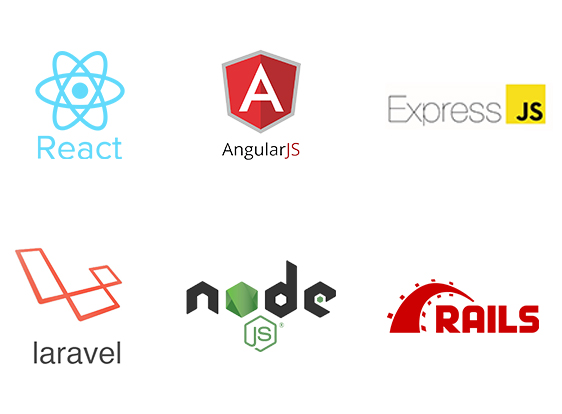Top Frontend and Backend Frameworks

JavaScript is a powerful scripting language and it’s one of the most used languages for web development. It has been popular for years and it continues to grow in popularity as an essential part of your toolkit. In this blog, we are discussing some of the top frontend and backend JavaScript frameworks that are available for developers.
Introduction to JavaScript Frameworks
When it comes to JavaScript frameworks, there are two main types: frontend and backend. Frontend frameworks are used for the client side of web applications, while backend frameworks are used for the server side. There are numerous JavaScript frameworks, each with its benefits and drawbacks. In this article, we will be taking a look at the top frontend and backend JavaScript frameworks.
Frontend Frameworks
React is a popular front-end framework created by Facebook. It uses a declarative paradigm and has been designed with simplicity and scalability in mind. React is also one of the most popular open-source projects on GitHub.
Angular is another popular front-end framework created by Google. It uses an imperative programming style and has a strong focus on performance. Angular is also widely used in large enterprise applications.
Backend Frameworks
Node.js is a popular backend framework that allows you to use JavaScript on the server side. Node.js is fast and scalable, making it ideal for large applications. It also has a large ecosystem of modules and libraries that can be used to extend its functionality.
Types of JavaScript Frameworks
There are two types of JavaScript frameworks: frontend and backend. Frontend frameworks include AngularJS, ReactJS, Vue.js, and Knockout. Backend frameworks include Node.js, Express.js, and Sails. Each type of framework has its own benefits and drawbacks. Frontend frameworks tend to be more flexible and offer a wider range of features than backend frameworks. However, they could also be more challenging to understand and use. Backend frameworks are typically easier to use but may not offer as many features as frontend frameworks.
Which type of framework you choose will depend on your needs and preferences. If you want a more powerful framework with a wide range of features, a front-end framework may be the better choice. If you want an easier-to-use framework that is still capable of powering a dynamic website or application, a backend framework may be the better option.

What is a Frontend Framework?
A frontend framework is a collection of JavaScript libraries that are used to build user interfaces and web applications. The most popular front-end frameworks are React, Angular, and Vue. Each framework has its own pros and cons, so it’s important to choose the right one for your project.
React is a declarative, component-based framework for creating UI. It is the most popular frontend framework, and it is used by major companies such as Facebook, Instagram, and Airbnb. React has a steep learning curve, but it is worth it because it makes creating reusable components easy.
Angular is a full-fledged framework that offers two-way data binding and helps developers create well-structured applications. It has a large community and many resources available, which makes learning Angular easier than React. However, Angular can be challenging to work with if you’re not familiar with TypeScript.
Vue is a lightweight framework that is easy to learn and use. It offers a simple API and few conventions, which makes it great for small projects. However, Vue doesn’t have as much support as React or Angular, so it might not be the best choice for large projects.
What is a back-end framework?
A backend framework is a software platform that provides common functionality for back-end web applications. Backend frameworks typically provide libraries and tools for database access, session management, authentication, and authorization. Some popular backend frameworks include Ruby on Rails, Django, and Express.
Advantages and disadvantages of frontend frameworks
Frontend JavaScript frameworks are great for building single-page web applications and for providing a structure to your code. However, there are some disadvantages to using a front-end framework.
One disadvantage is that frontend frameworks can be large and complex and may take a long time to load. This can make your web application slower and more resource-intensive than if you were just using vanilla JavaScript.
Another disadvantage is that because frontend frameworks are so popular, there is a lot of code written for them that is not compatible with older browsers. This means that your users may not be able to view your web application if they are using an older browser. Finally, frontend frameworks can be difficult to learn and use if you are not already familiar with them. If you want to use a frontend framework, it is important to spend some time learning how it works before you start building your application.
Advantages and disadvantages of backend frameworks.
There are many different backend frameworks available for developers to choose from. Each framework has its advantages and disadvantages that should be considered before making a decision.

The following are a few of the most well-known backend frameworks
- Laravel: Laravel is a PHP framework that is designed for developers who need a simple and elegant toolkit to create full-featured web applications. Laravel provides an easy way to organize your application’s codebase and makes it easy to deploy your applications to production servers.
- Ruby on Rails: Ruby on Rails is a popular web application framework written in the Ruby programming language. Ruby on Rails is well known for its ease of use and convention over configuration design philosophy.
- Express: Express is a lightweight Node.js web application framework that provides a wide range of features for building web applications and APIs. Express is very popular due to its flexibility and minimalistic approach.
Each of these frameworks has its own unique set of features and benefits that make it well-suited for specific types of projects. It’s important to weigh the pros and cons of each option before deciding which one is right for your project. As you can see, there are many different options available to choose from when deciding on a JavaScript framework. The key is to find one that best suits your needs based on the size and scope of your project. Keep in mind that both frontend and backend frameworks have their own unique benefits and drawbacks, so be sure to do your research before making a final decision. Whichever framework you ultimately choose, we hope that it helps you create a successful and efficient web application.
Related articles



